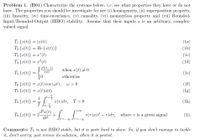
Introductory Circuit Analysis (13th Edition)
13th Edition
ISBN: 9780133923605
Author: Robert L. Boylestad
Publisher: PEARSON
expand_more
expand_more
format_list_bulleted
Question
thumb_up100%

Transcribed Image Text:Problem 1. (B01) Characterize the systems below, i.e. see what properties they have or do not
us-00 JT=-
have. The properties you should be investigate for are (i) homogeneity, (ii) superposition property,
(iii) linearity, (iv) time-invariance, (v) causality, (vi) memoryless property and (vii) Bounded-
Input/Bounded-Output (BIBO) stability. Assume that their inputs z is an arbitrary, complex-
valued signal.
T {x(t)} = |x(t)|
T2 {r(t)} = Re {x(t))}
(la)
(1b)
T3 {r(t)} = x*(t)
TA {r(t)} = x²(t)
x² (t-1)
(lc)
(ld)
when r(t) + 0
T3 {x(t)} =
r(t)
(le)
otherwise
T6 {r(t)} = x(t) cos (wt), w> 0
T7 {r(t)} = x(t)u(t)
(1f)
(1g)
1
Ts {r(t)} =
T
I(T)dr, T> 0
(1h)
dr(t)
T9 {r(t)} = 2.
dt2
t
rtoo
| v(T)x(t' –T)dr, where v is a given signal
(li)
Comments: T; is not BIBO stable, but it is quite hard to show. So, if you don't manage to tackle
it, don't worry; just review its solution, when it is posted.
Expert Solution
This question has been solved!
Explore an expertly crafted, step-by-step solution for a thorough understanding of key concepts.
This is a popular solution
Trending nowThis is a popular solution!
Step by stepSolved in 2 steps

Knowledge Booster
Similar questions
- Determine the step size for a 4-bit ADC having a range of 10V. Also, convert an analog sample of 3 V into the 4-bit digits using Successive approximation methodarrow_forwardUse the successive approximation method to find an 8-bit encoding for an analog voltage of 5V if the voltage range is 0V (min) to 15 V (max). Please make sure to show all the steps.arrow_forward
Recommended textbooks for you
 Introductory Circuit Analysis (13th Edition)Electrical EngineeringISBN:9780133923605Author:Robert L. BoylestadPublisher:PEARSON
Introductory Circuit Analysis (13th Edition)Electrical EngineeringISBN:9780133923605Author:Robert L. BoylestadPublisher:PEARSON Delmar's Standard Textbook Of ElectricityElectrical EngineeringISBN:9781337900348Author:Stephen L. HermanPublisher:Cengage Learning
Delmar's Standard Textbook Of ElectricityElectrical EngineeringISBN:9781337900348Author:Stephen L. HermanPublisher:Cengage Learning Programmable Logic ControllersElectrical EngineeringISBN:9780073373843Author:Frank D. PetruzellaPublisher:McGraw-Hill Education
Programmable Logic ControllersElectrical EngineeringISBN:9780073373843Author:Frank D. PetruzellaPublisher:McGraw-Hill Education Fundamentals of Electric CircuitsElectrical EngineeringISBN:9780078028229Author:Charles K Alexander, Matthew SadikuPublisher:McGraw-Hill Education
Fundamentals of Electric CircuitsElectrical EngineeringISBN:9780078028229Author:Charles K Alexander, Matthew SadikuPublisher:McGraw-Hill Education Electric Circuits. (11th Edition)Electrical EngineeringISBN:9780134746968Author:James W. Nilsson, Susan RiedelPublisher:PEARSON
Electric Circuits. (11th Edition)Electrical EngineeringISBN:9780134746968Author:James W. Nilsson, Susan RiedelPublisher:PEARSON Engineering ElectromagneticsElectrical EngineeringISBN:9780078028151Author:Hayt, William H. (william Hart), Jr, BUCK, John A.Publisher:Mcgraw-hill Education,
Engineering ElectromagneticsElectrical EngineeringISBN:9780078028151Author:Hayt, William H. (william Hart), Jr, BUCK, John A.Publisher:Mcgraw-hill Education,

Introductory Circuit Analysis (13th Edition)
Electrical Engineering
ISBN:9780133923605
Author:Robert L. Boylestad
Publisher:PEARSON

Delmar's Standard Textbook Of Electricity
Electrical Engineering
ISBN:9781337900348
Author:Stephen L. Herman
Publisher:Cengage Learning

Programmable Logic Controllers
Electrical Engineering
ISBN:9780073373843
Author:Frank D. Petruzella
Publisher:McGraw-Hill Education

Fundamentals of Electric Circuits
Electrical Engineering
ISBN:9780078028229
Author:Charles K Alexander, Matthew Sadiku
Publisher:McGraw-Hill Education

Electric Circuits. (11th Edition)
Electrical Engineering
ISBN:9780134746968
Author:James W. Nilsson, Susan Riedel
Publisher:PEARSON

Engineering Electromagnetics
Electrical Engineering
ISBN:9780078028151
Author:Hayt, William H. (william Hart), Jr, BUCK, John A.
Publisher:Mcgraw-hill Education,